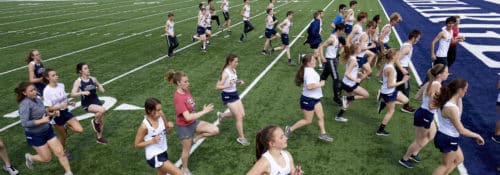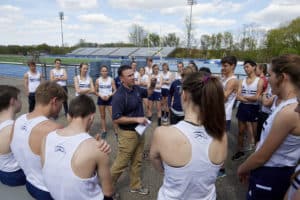
Mind and Body: Why Physical Education Needs to be an Essential Feature of Classical Education
 Physical education: Where does it fit in today’s classical schools? Is it an afterthought or a filler class to give the homeroom teacher a free period? Far from it! In a presentation for teachers at Barney Charter School Initiative schools, Hillsdale Academy Assistant Headmaster and Athletic Director Mike Roberts argued that physical education has held an important place in education from antiquity and offered advice for integrating a physical education program within a K-12 classical education model.
Physical education: Where does it fit in today’s classical schools? Is it an afterthought or a filler class to give the homeroom teacher a free period? Far from it! In a presentation for teachers at Barney Charter School Initiative schools, Hillsdale Academy Assistant Headmaster and Athletic Director Mike Roberts argued that physical education has held an important place in education from antiquity and offered advice for integrating a physical education program within a K-12 classical education model.
Roberts began by referencing a passage in Plato’s Republic, in which Plato discusses gymnastics and music, two of the four aspects of education. Gymnastics, in this context, refers to physical training of the whole body, and music refers not only to music as we know it, but also the literary arts. According to Plato, humans must have balance; too much focus on music makes one soft, while too much focus on gymnastics makes one savage. A harmony between the disciplines fosters a moderate and courageous soul.
With that principle in mind, Roberts offered suggestions for how classical schools can integrate physical education into their curriculum.
- Teach games that have rules. In The Republic, Plato advocated for teaching children games with rules. This will cultivate good habits in kids that will follow them to adulthood. “We have to teach children, early on, the habits about how to play, about how to win and lose,” Roberts said. He also noted that teachers have a tremendous opportunity to model virtue while teaching students about winning and losing.
- Schedule physical education classes during the school day. Roberts cited a case in which a Naperville, Illinois, school, in trying to determine why its test scores were so high, realized that physical education classes were often scheduled before the most difficult academic class. “When you exercise, it helps to increase your focus and reduce your stress level,” Roberts said. “Students perform better after physical education.”
- Design your physical education program for every student. After World War II, the focus of physical education courses in the United States shifted toward sports. This led to non-athletic students feeling alienated and resulted in negativity toward physical education. “A physical education program should not only be a means to a varsity sport,” Roberts said. “The goal of physical education should be the same as any other subject—the continual cultivation of body, mind, and soul.” He also emphasized that physical education should teach students habits that will lead to lifelong fitness and good nutrition.
- Create an athletic program with intentionality. Just like physical education classes, a school’s athletic program must remain focused on the mission of teaching virtue while strengthening the body. “You must treat an athletic program as you do your academic program,” Roberts said. An athletic program also has the potential to create school unity. “Try to connect all students to sports even if they’re not on the team—through the pep band, a student section, or school cheers.”
- Help everyone understand the value of a physical education program. It’s critical to reach everyone—beyond the students—connected to the school and share why physical education is important, Roberts said. “Ask teachers if their students are more focused after PE class. Tell your school board how physical education serves the school’s purpose. Communicate with parents the ways in which their child is leading, or areas in which they need to work. Involve your community through events such as Jump Rope for Heart or Relay for Life.”
“We spend a lot of time talking about forming our hearts and minds,” Roberts said. “But our bodies require that as well. If we neglect the body, we won’t maximize what the mind can do.” Therefore, a good physical education program contributes to a continual cultivation of virtue while developing the body and the mind.